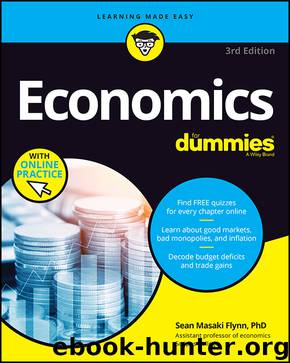Economics For Dummies by Sean Masaki Flynn

Author:Sean Masaki Flynn
Language: eng
Format: epub
ISBN: 9781119476276
Publisher: Wiley
Published: 2018-05-22T00:00:00+00:00
Grouping individuals to help tell them apart
Insurance companies have come up with a paradoxical way of dealing with the fact that they can’t tell whether an individual is a good or bad driver. Instead of focusing on the individual, they look for clues about the individual based on the groups to which he or she belongs. Doing so often gives the insurance companies a pretty good idea about whether the individual is a good or bad driver.
For instance, government data indicates that males under 25 get into many more serious accidents than females under 25 do. So if two people walk into an insurance company and one of them is a 23-year-old male and the other is a 22-year-old female, chances are that the male is a worse driver than the female. Consequently, you charge the male a higher insurance rate.
This situation has the nice result of making sure that everybody can get insurance at what is likely to be a fair price given the fact that, on average, males under 25 get into many more accidents than females under 25.
In reality, this nice result isn’t the compelling reason behind insurance companies’ decisions to infer as much as possible about their customers by looking at which groups they belong to. These companies really have no choice; competition forces them to do so.
Why is this true? Consider two insurance companies, only one of which uses group membership information to help set rates. The company that doesn’t use group information has to set very high rates because it’s afraid that all its customers may be bad drivers. Doing so drives away the good drivers who don’t want to pay bad-driver rates for their insurance.
But the company that uses group information can offer multiple rates, such as high ones to young men and lower ones to young women. Doing so allows it to capture the business of many good drivers who don’t want to deal with the first insurance company that sets only one high rate for everyone. The result is that insurance companies are always looking for ways to estimate an individual’s unknown risk profile based on the well-known risk profiles of the groups to which he or she belongs.
This process can lead to some rather unfair conclusions. The oddest is that good-driving young males end up paying higher rates than good-driving young females because the only thing insurance companies have to go on is gender. But such a system is still better than the even more unfair alternative in which all good drivers would have to pay bad-driver rates, which is what would happen if insurance companies were banned from using group membership information to try to distinguish their customers. The closer insurance companies can get to fully distinguishing good and bad drivers using group membership information, the fairer rates will be.
Keep in mind that the drivers for whom insurance companies have the greatest need to use group membership information are new drivers. Because insurance companies don’t have any accident or
Download
This site does not store any files on its server. We only index and link to content provided by other sites. Please contact the content providers to delete copyright contents if any and email us, we'll remove relevant links or contents immediately.
International Integration of the Brazilian Economy by Elias C. Grivoyannis(75624)
The Radium Girls by Kate Moore(11634)
Turbulence by E. J. Noyes(7717)
Nudge - Improving Decisions about Health, Wealth, and Happiness by Thaler Sunstein(7261)
The Black Swan by Nassim Nicholas Taleb(6782)
Rich Dad Poor Dad by Robert T. Kiyosaki(6192)
Pioneering Portfolio Management by David F. Swensen(6089)
Man-made Catastrophes and Risk Information Concealment by Dmitry Chernov & Didier Sornette(5671)
Zero to One by Peter Thiel(5503)
Secrecy World by Jake Bernstein(4402)
Millionaire: The Philanderer, Gambler, and Duelist Who Invented Modern Finance by Janet Gleeson(4113)
The Age of Surveillance Capitalism by Shoshana Zuboff(3999)
Skin in the Game by Nassim Nicholas Taleb(3978)
The Money Culture by Michael Lewis(3857)
Bullshit Jobs by David Graeber(3847)
Skin in the Game: Hidden Asymmetries in Daily Life by Nassim Nicholas Taleb(3736)
The Dhandho Investor by Mohnish Pabrai(3573)
The Wisdom of Finance by Mihir Desai(3538)
Blockchain Basics by Daniel Drescher(3340)
